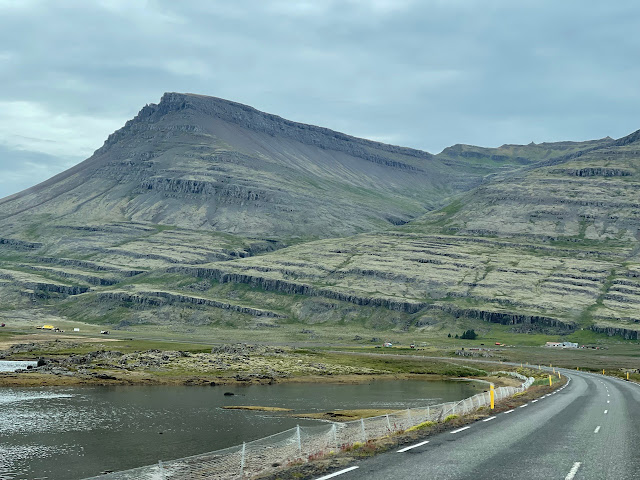East Coast
After leaving the town of Egilsstadir in Iceland's northeast corner, the three of us drove along the least visited side of the country. We had another stellar day, overcast but with clear views of the mountains.

Layer after layer of late Miocene (about 9 Ma) basalt lava flows are seen on this stretch. Note the two vertical dikes on the right side of the photograph that stands out in erosional prominence and cut through the older lava flows. Other ravines in this view may also be the location of dikes that have alternatively eroded more deeply in to the flows.
There are many long tunnels in Iceland that cut through the mountains to shorten driving times or bypass steep or often-snowbound stretches of road. This one is six kilometers (four miles) long.
All around Iceland's coast, the layered basalt rocks are tilted inward to the center of the island (and away from the sea). This is due to isostatic rebound being more pronounced along the coasts, where ice-free environments began much earlier at the end of the last Ice Age. In other words, the central part of the island is still being depressed from the weight of the still-existent (or recently removed) ice, while the coastal areas have been rebounding for longer periods of time. Amazing!
One place has scree coming directly to the coast right off of the mountains. A road was not constructed across this scree until the early parts of the 20th century.
South Coast
After passing the town of Hofn, the road swings west to travel along the south coast.
I had been hearing about a canyon along this part of the coast and decided to explore a bit and take a look. Luckily, I had two folks who by now were way into anything resembling "Exploration." It turned out to be well worth it!
A medial moraine is seen snaking its way on top of the glacier and represents where two valley glaciers coalesced as they flowed downstream.
Skogafoss on the south coast. There are actually about 50 people looking at the waterfall but I placed my camera in a position where the nearby grass obstructed them.
An eroded subglacial volcano along the Ring Road. Note the tilted beds of palagonite where the effusive material was trapped beneath the glacier and avalanched downslope.
Seljalandsfoss was a final waterfall visited in a land of waterfalls! Some visitors to Iceland report having waterfall fatigue on their journeys. There are many!
In the anteroom. Thanks for reading!























Beautiful landscapes -- and photos! Fjadrarglijufur Canyon is especially appealing! Thanks!
ReplyDeleteHoly cow! a four mile tunnel! I love the "F" canyon. No way will I try to spell it though.
ReplyDelete